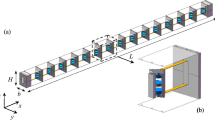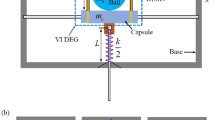Abstract
Electrostatically-driven microelectromechanical systems (MEMS) devices are mathematically modelled using one dimensional approximation to study the nonlinear dynamics of the resonators. It is observed that the electrostatic fringing field affects the pull dynamics of MEMS resonators. The existing fringing field models are developed under assumption of infinitely wide rigid grounded beam as compared to the deformable beam. These models considered parameters which depends upon the thickness and the width of the elastic beam. In general, the MEMS resonators which are used for practical applications cannot have infinitely wide rigid grounded beam. In this work, a new fringing field model is developed to take into the account the finite width of the rigid beam electrode. A new parameter \(\gamma \) which accounts the fringing field effect due to the finite width of deformable and grounded rigid beam electrodes is introduced. The performance of the new fringing field model is compared with the existing fringing models for different cases. It is observed that the new fringing field model performance better for all test cases.






Similar content being viewed by others
References
Dean, R.N., Luque, A.: Applications of microelectromechanical systems in industrial processes and services. IEEE Trans. Industr. Electron. 56(4), 913–925 (2009)
Oh, K.W., Ahn, C.H.: A review of microvalves. J. Micromech. Microeng. 16(5), 13 (2006)
Nisar, A., Afzulpurkar, N., Mahaisavariya, B., Tuantranont, A.: Mems-based micropumps in drug delivery and biomedical applications. Sens. Actuators B Chem. 130(2), 917–942 (2008)
Mariani, S., Ghisi, A., Corigliano, A., Zerbini, S.: Multi-scale analysis of mems sensors subject to drop impacts. Sensors 7(9), 1817–1833 (2007)
Rezazadeh, G., Fathalilou, M., Sadeghi, M.: Pull-in voltage of electrostatically-actuated microbeams in terms of lumped model pull-in voltage using novel design corrective coefficients. Sens. Imag. Int. J. 12, 117–131 (2011)
Zhang, W.-M., Yan, H., Peng, Z.-K., Meng, G.: Electrostatic pull-in instability in mems/nems: a review. Sens. Actuators A 214, 187–218 (2014)
Fang, D., Zheng, F., Chen, B., Wang, Y., Fang, Y., Yang, P., Wen, X., Peng, C., Xia, S.: Computation of capacitance and electrostatic forces for the electrostatically driving actuators considering fringe effects. Microsyst. Technol. 21, 2089–2096 (2015)
Palmer, H.B.: The capacitance of a parallel-plate capacitor by the schwartz-christoffel transformation. Electr. Eng. 56(3), 363–368 (1937)
Batra, R.C., Porfiri, M., Spinello, D.: Electromechanical model of electrically actuated narrow microbeams. J. Microelectromech. Syst. 15(5), 1175–1189 (2006)
Elliott, R.: Electromagnetics number 66–14804. McGraw Hill, Newyork (1966)
Chang, W.: Analytical IC metal-line capacitance formulas. IEEE Trans. Microw. Theory Tech. 25, 712 (1977)
Yuan, C., Trick, T.N.: A simple formula for the estimation of the capacitance of two-dimensional interconnects in VLSI circuits. IEEE Electron Device Lett. 3(12), 391–393 (1982)
Sakura, T., Tamaru, K.: Simple formulas for two-and three-dimensional capacitance. IEEE Trans. Electron Devices 30, 183–185 (1983)
Leus, V., Elata, D.: Fringing field effect in electrostatic actuators. Technion-Israel Institute of Technology technical report no ETR-2004-2 (2004)
Van Der Meijs, N., Fokkema, J.: VLSI circuit reconstruction from mask topology. Integration 2(2), 85–119 (1984)
Author information
Authors and Affiliations
Corresponding author
Additional information
Publisher's Note
Springer Nature remains neutral with regard to jurisdictional claims in published maps and institutional affiliations.
Rights and permissions
Springer Nature or its licensor (e.g. a society or other partner) holds exclusive rights to this article under a publishing agreement with the author(s) or other rightsholder(s); author self-archiving of the accepted manuscript version of this article is solely governed by the terms of such publishing agreement and applicable law.
About this article
Cite this article
Kumar, R., Parayil, D. & Gaonkar, A.K. Novel fringing field model for MEMS resonators. Int J Adv Eng Sci Appl Math (2023). https://doi.org/10.1007/s12572-023-00357-0
Accepted:
Published:
DOI: https://doi.org/10.1007/s12572-023-00357-0




